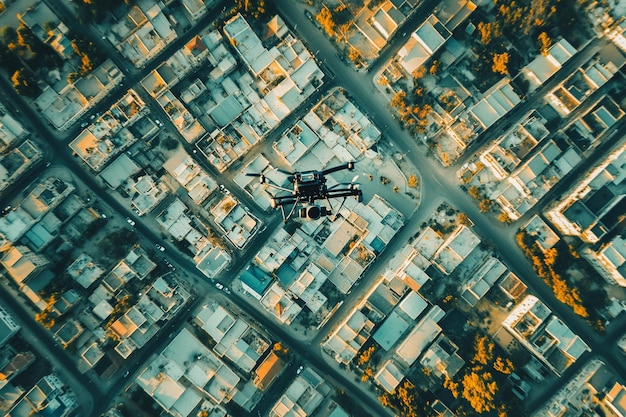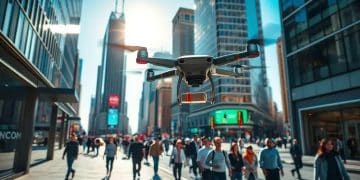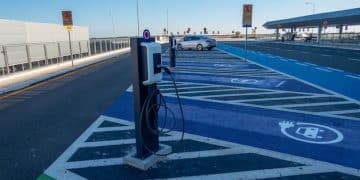Drone Delivery in the US: Navigating Challenges for Scalable Operations

Drone delivery in the US: Overcoming challenges and scaling operations involves addressing regulatory hurdles, technological limitations, and logistical complexities to establish a reliable and efficient delivery network.
The prospect of drones filling the skies, delivering packages with speed and efficiency, has captured the imagination for years. **Drone delivery in the US: Overcoming challenges and scaling operations** is not merely a futuristic fantasy, but a tangible goal within reach, yet significant hurdles remain before widespread adoption becomes a reality.
The Promise of Drone Delivery in the US
Drone delivery offers the potential to revolutionize the way goods are transported, particularly in urban and suburban areas. It promises faster delivery times, reduced traffic congestion, and lower carbon emissions compared to traditional methods. However, realizing this vision requires a multi-faceted approach, tackling regulatory, technological, and logistical challenges head-on.
Speed and Efficiency
One of the most compelling arguments for drone delivery is its potential to significantly reduce delivery times. Drones can bypass traffic congestion, taking direct routes to their destinations, leading to near-instant delivery in some cases.
Environmental Benefits
Compared to gasoline-powered vehicles, drones offer a more sustainable delivery solution. Electric drones produce zero emissions during operation, contributing to cleaner air and reduced carbon footprint. Furthermore, optimized delivery routes can reduce overall energy consumption.
- Reduced delivery times, especially in congested areas.
- Lower operational costs compared to traditional delivery methods.
- Environmentally friendly with zero emissions during flight.
- Increased accessibility to remote or hard-to-reach locations.
The benefits of drone delivery are clear, yet these advantages can only be realized if the challenges are properly addressed. Creating a safe, efficient, and scalable drone delivery network requires careful planning and execution.

Navigating the Regulatory Landscape
The regulatory landscape in the US poses a significant challenge for drone delivery operations. The Federal Aviation Administration (FAA) sets the rules for drone operations, and navigating these regulations can be complex and time-consuming. Gaining the necessary approvals and waivers is crucial for any drone delivery company.
FAA Regulations and Waivers
The FAA has established a framework for drone operations, covering aspects such as remote identification, airspace restrictions, and operational limitations. Drone delivery companies must obtain waivers to operate beyond these limitations, such as flying beyond visual line of sight (BVLOS) or over people.
State and Local Regulations
In addition to federal regulations, drone delivery operations may also be subject to state and local laws. These regulations can vary widely, covering issues such as noise levels, privacy concerns, and operational restrictions. Understanding and complying with these diverse regulations is essential for successful drone delivery operations.
- Obtaining necessary FAA approvals for BVLOS operations.
- Complying with state and local regulations regarding noise and privacy.
- Establishing standardized safety protocols and training programs.
- Working with government agencies to develop clear regulatory guidelines.
The regulatory landscape is constantly evolving, and staying up-to-date on the latest changes is vital for drone delivery companies. Collaboration with regulatory bodies and industry stakeholders is crucial to shape the future of drone delivery regulations in the US.
Technological Hurdles and Solutions
While drone technology has advanced rapidly in recent years, several technical challenges remain before widespread drone delivery becomes a reality. These challenges include improving battery life, enhancing drone autonomy, and ensuring safe operation in all weather conditions.
Extending Battery Life
Limited battery life is a significant constraint for drone delivery operations. Longer flight times are needed to cover greater distances and serve more customers. Research and development efforts are focused on improving battery technology, exploring alternative power sources, and optimizing drone design for energy efficiency.
Enhancing Drone Autonomy
Autonomous flight is essential for scaling drone delivery operations. Drones need to be able to navigate complex environments, avoid obstacles, and make real-time decisions without human intervention. Advanced sensors, artificial intelligence, and machine learning algorithms are being developed to enhance drone autonomy and improve safety.

Weather Resilience
Adverse weather conditions can significantly impact drone delivery operations. Rain, snow, and high winds can compromise drone stability and safety. Developing weather-resistant drones and implementing robust weather monitoring systems are crucial for ensuring reliable service.
Overcoming these technological hurdles requires ongoing innovation and investment in research and development. Collaboration between drone manufacturers, software developers, and logistics companies is essential to create robust and reliable drone delivery systems.
Building a Scalable Drone Delivery Infrastructure
Creating a scalable drone delivery network requires a well-designed infrastructure that supports efficient and reliable operations. This includes establishing strategically located droneports, optimizing delivery routes, and implementing effective inventory management systems.
Strategic Droneport Locations
Droneports serve as hubs for drone operations, providing facilities for takeoff, landing, package handling, and maintenance. The location of droneports is critical for optimizing delivery routes and minimizing flight times. Factors such as population density, airspace availability, and accessibility to transportation networks must be considered when selecting droneport locations.
Optimized Delivery Routes
Efficient delivery routes are essential for minimizing flight times, conserving battery life, and maximizing the number of deliveries per drone. Advanced route optimization algorithms can analyze factors such as traffic patterns, weather conditions, and delivery schedules to determine the most efficient routes.
Effective Inventory Management
Seamless inventory management is crucial for ensuring that the right packages are delivered to the right customers at the right time. Integrated inventory management systems can track packages from the moment they enter the system to the moment they are delivered, providing real-time visibility and minimizing errors.
- Establishing a network of strategically located droneports.
- Implementing advanced route optimization algorithms.
- Integrating inventory management systems for real-time tracking.
- Developing standardized procedures for package handling and delivery.
Building a scalable drone delivery infrastructure requires careful planning, strategic investment, and collaboration between various stakeholders. The successful implementation of this infrastructure will pave the way for widespread drone delivery adoption.
Addressing Safety and Security Concerns
Safety and security are paramount concerns for drone delivery operations. Measures must be taken to prevent accidents, protect against theft, and ensure the privacy of individuals. Implementing robust safety protocols and security measures is crucial for building public trust and gaining regulatory approval.
Collision Avoidance Systems
Collision Avoidance Systems are essential for preventing accidents. Drones need to be equipped with sensors and software that can detect and avoid obstacles, such as other aircraft, buildings, and power lines. Redundancy in these systems is also important to ensure continued operation in case of component failure.
Package Security
Protecting packages from theft is a major concern for drone delivery operations. Measures such as tamper-evident packaging, secure delivery lockers, and real-time GPS tracking can help to deter theft and ensure the safe delivery of packages.
Privacy Protection
Drones equipped with cameras raise privacy concerns. Regulations and protocols need to be put in place to protect the privacy of individuals. This includes limiting the use of cameras, anonymizing data, and ensuring compliance with privacy laws.
Addressing safety and security concerns requires a proactive and comprehensive approach. Collaboration between drone manufacturers, software developers, and regulatory agencies is essential to develop and implement effective safety and security measures.
The Future of Drone Delivery in the US: Scaling Operations
As technology advances, regulatory frameworks evolve, and public acceptance grows, the future of drone delivery in the US looks promising. Scaling operations will involve expanding service areas, increasing delivery volumes, and integrating drone delivery into existing logistics networks.
Expanding Service Areas
Initially, drone delivery services are likely to focus on densely populated urban and suburban areas. As the technology matures and regulatory approvals are obtained, service areas will expand to include more rural and remote locations. This will require overcoming challenges such as longer flight distances, harsher weather conditions, and lower population densities.
Increasing Delivery Volumes
As drone delivery becomes more established, delivery volumes will increase significantly. This will require optimizing droneport operations, streamlining package handling processes, and implementing efficient delivery schedules. Automation and artificial intelligence will play a key role in managing high delivery volumes.
Integration with Logistics Networks
Drone delivery will increasingly be integrated into existing logistics networks. This will involve coordinating drone deliveries with traditional delivery methods, such as trucks and vans. Seamless integration will require sophisticated software systems that can optimize delivery routes, manage inventory, and track packages in real-time.
- Expanding drone delivery services to new geographic areas.
- Increasing the volume of deliveries per drone.
- Integrating drone delivery into existing logistics networks.
- Developing new and innovative drone delivery applications.
The future of drone delivery in the US is bright, with the potential to transform the way goods are transported. By addressing the challenges and embracing innovation, drone delivery can become a safe, efficient, and sustainable solution for the future.
| Key Point | Brief Description |
|---|---|
| 🚀 Regulatory Hurdles | Navigating FAA regulations and state/local laws for drone operations. |
| 🔋 Technological Challenges | Improving battery life, drone autonomy, and weather resilience for dependable delivery. |
| 📦 Scalable Infrastructure | Building efficient droneports, optimizing routes, and managing inventory effectively. |
| 🛡️ Safety & Security | Ensuring safety, theft prevention, and privacy protection for public trust. |
FAQ
▼
Navigating FAA regulations, obtaining necessary waivers like BVLOS, and complying with varying state and local laws pose significant regulatory challenges for drone delivery operations.
▼
Battery life limitations can be addressed through advancements in battery technology, exploration of alternative power sources, and optimization of drone design for enhanced energy efficiency.
▼
Strategic droneport locations are crucial for efficient operations by minimizing flight times and maximizing delivery routes. Factors like population density and airspace availability are critical for droneport placement.
▼
Package theft prevention involves using tamper-evident packaging, secure delivery lockers, and real-time GPS tracking to ensure packages reach the intended recipients securely.
▼
The future involves expanding service areas, increasing delivery volumes, and integrating drone delivery into existing logistics networks, revolutionizing the transportation of goods in the US.
Conclusion
Drone delivery in the US holds immense potential, but realizing this vision requires overcoming regulatory hurdles, technological limitations, and logistical complexities. By addressing these challenges and embracing innovation, drone delivery can transform the way goods are transported, creating a more efficient, sustainable, and convenient delivery system for the future.





